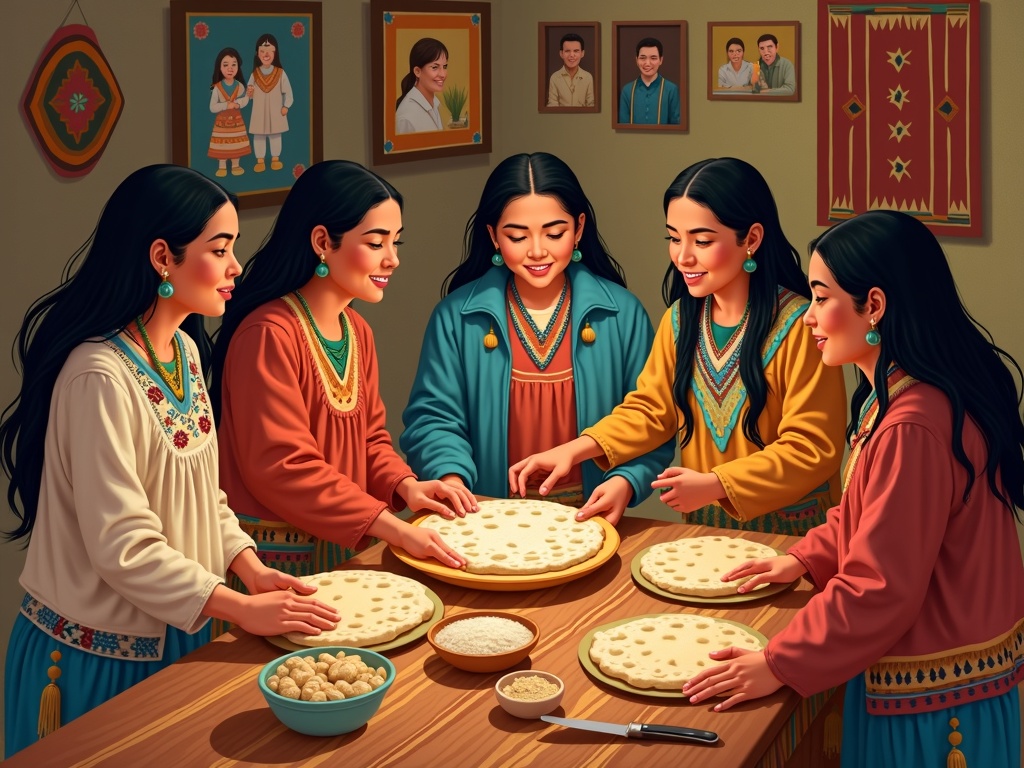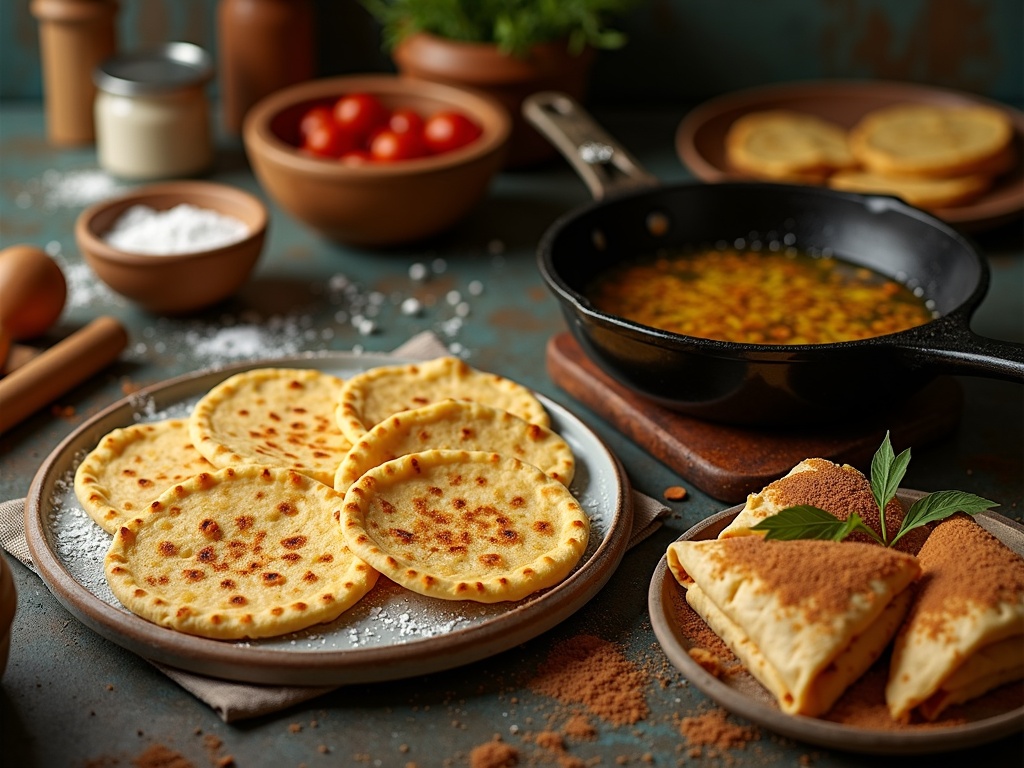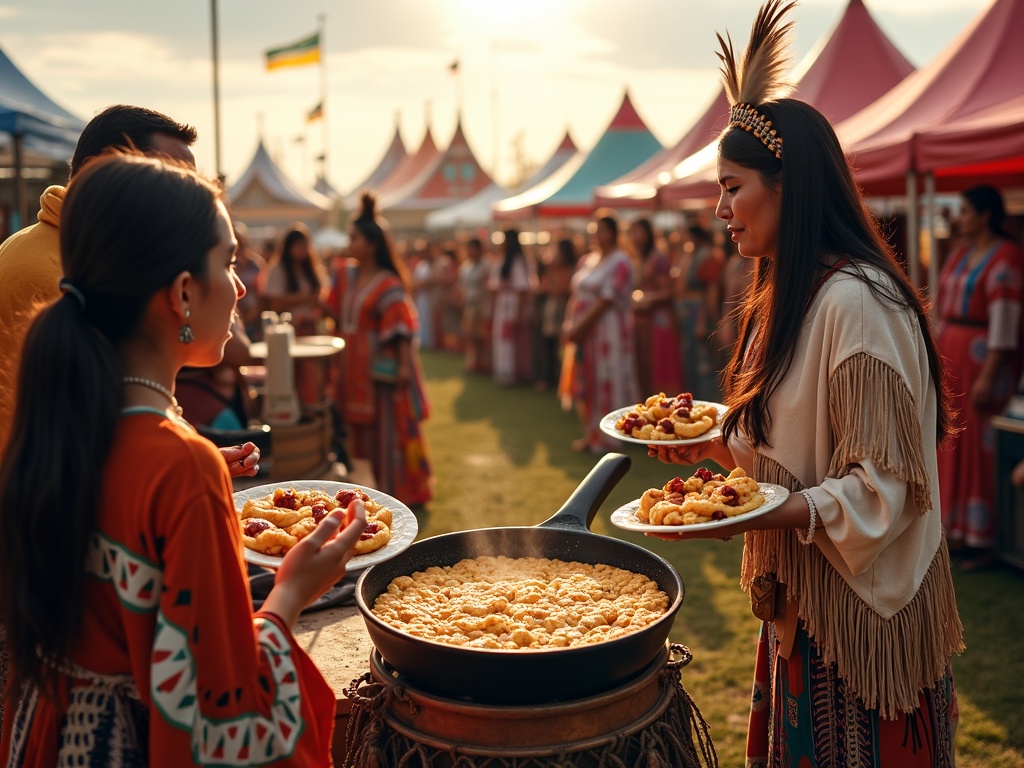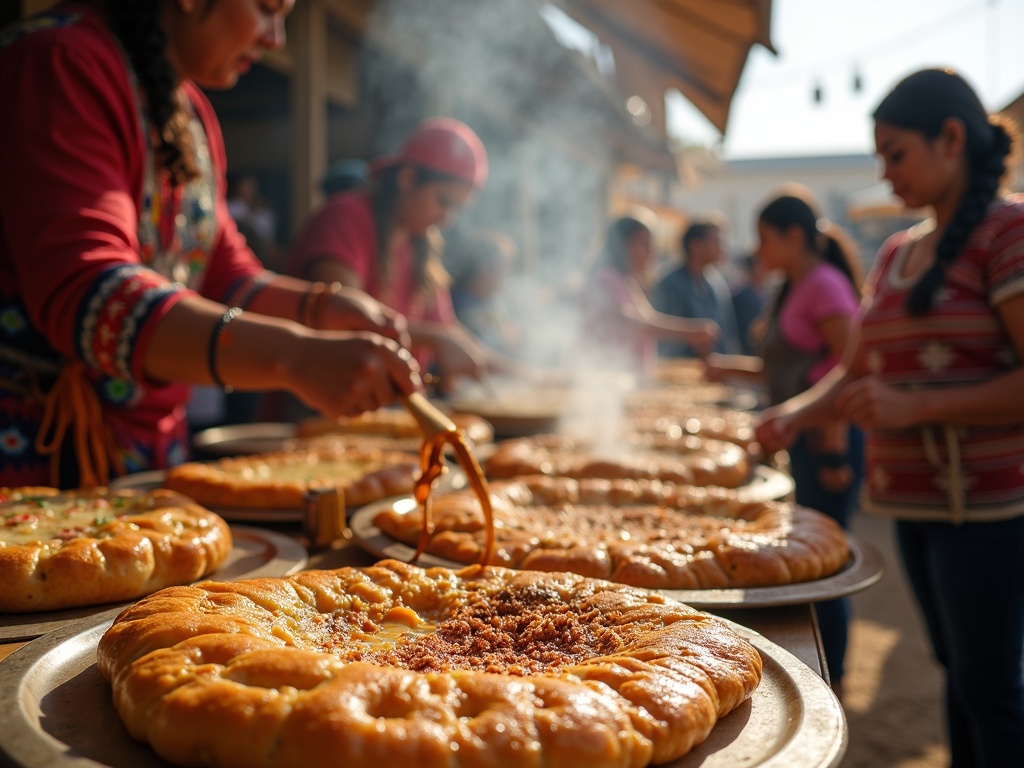Native American fried bread started during the 1864 forced Navajo relocation, evolving from a survival food into a symbol of cultural resilience. This simple bread, with variations across tribes, connects people to their heritage beyond its basic ingredients.
Find In This Article
Key Takeaways
- Frybread emerged during the traumatic Long Walk when Navajo people created it from unfamiliar government-issued rations of flour, sugar, and lard.
- Regional variations exist across tribal nations, with differences in thickness, texture, and flavor reflecting diverse cultural practices.
- Despite its origins in historical trauma, frybread has become a cultural touchstone that brings communities together during celebrations and everyday meals.
- Traditional frybread requires simple ingredients (flour, salt, baking powder, water) and specific techniques, with the proper oil temperature being critical for ideal results.
- Modern adaptations of frybread include healthier versions using whole grains or alternative cooking methods, addressing nutritional concerns while preserving cultural connections.
The Cultural Legacy of Native American Frybread
Native American frybread carries a profound historical significance that reaches far beyond its simple ingredients. This humble yet delicious bread emerged during one of the darkest chapters in Native American history—the 1864 Long Walk, when thousands of Navajo people were forcibly relocated from their ancestral homelands to eastern New Mexico.
During this brutal 300-mile journey, the U.S. government provided the displaced Navajo people with unfamiliar rations including flour, sugar, and lard. Facing starvation and armed with these foreign ingredients, the Navajo women created what we now know as frybread—a testament to human ingenuity in the face of adversity.
I’ve discovered that frybread has evolved into more than just food; it represents the resilience and survival of Native American communities. Despite originating from a traumatic period, it has transformed into a cultural touchstone that brings families together during celebrations, powwows, and everyday meals.
Regional Variations Across Tribes
The beauty of frybread lies in its diversity across different tribal nations. Each community has adapted the basic recipe to reflect their own cultural practices and available ingredients:
- Navajo-style frybread tends to be flat yet fluffy, often larger in diameter with a golden-brown exterior and a soft, airy interior.
- Ojibwe frybread is typically denser and chewier, sometimes incorporating additional ingredients like cornmeal.
- Some tribal variations feature slightly sweet dough while others focus on savory applications.
- The thickness can vary dramatically—from thin and crispy to thick and pillowy.
I find the traditional flatbread techniques used in frybread making particularly fascinating, as they reflect similar methods seen across many cultures.
The connection between frybread and the Navajo Nation runs especially deep. What began as survival food has become deeply intertwined with cultural identity. At many Navajo gatherings, frybread serves as both nourishment and a powerful reminder of their ancestors’ ability to persevere.
Some families guard their frybread recipes carefully, passing down specific techniques from generation to generation. The subtle differences—a particular way of kneading the dough, the exact temperature of the oil, or the precise moment to flip the bread—create distinctive family variations that carry emotional significance.
Modern Native American chefs have begun exploring the complex legacy of frybread, acknowledging both its painful origins and its role in cultural preservation. Some create elevated versions incorporating traditional cooking elements that predated colonial influence, while others focus on healthier adaptations that address contemporary health concerns.
For many Native Americans, particularly those of Navajo descent, frybread embodies a complicated duality. It represents both historical trauma and the extraordinary resilience of a people who refused to disappear. The simple act of making frybread connects contemporary Native Americans to their ancestors who endured unimaginable hardship.
When I attend cultural events featuring Native American cuisine, I’m struck by how frybread serves as a conversation starter about indigenous history. What appears to outsiders as simply delicious food carries layers of meaning for tribal members—a tangible link to their past and a symbol of cultural continuity despite centuries of attempted erasure.
The legacy of frybread reminds us that food is never just sustenance—it carries stories, memories, and cultural knowledge that might otherwise be lost. Through this humble bread, Native American communities continue to honor their past while creating new traditions for future generations.

How to Make Traditional Frybread
Traditional frybread is a deceptively simple yet incredibly satisfying food that has become a staple in many cultures. I’ve spent years perfecting my technique, and I’m excited to share my knowledge with you. Making this golden, crispy delight requires just a few basic ingredients and some attention to detail.
The Perfect Frybread Recipe
The foundation of any good frybread starts with a straightforward dough. To create it, I mix 2 cups of all-purpose flour, 1 teaspoon of salt, and 1 tablespoon of baking powder. Then I gradually add about ¾ cup of warm water until the mixture forms a soft, pliable dough. After kneading it for 5 minutes, I let it rest for at least 30 minutes – this resting period is crucial for developing the right texture.
When it’s time to cook, I heat vegetable oil to 350°F (175°C) in a deep pan. The temperature is critical – too cool and the bread absorbs too much oil, too hot and it browns before cooking through. I flatten portions of dough into discs about ¼ inch thick and gently place them in the hot oil. Each piece needs about 2-3 minutes per side until it reaches that beautiful golden-brown color.
Different regions have their own special touches. Some add a pinch of sugar to the dough, while others incorporate spices like cumin or coriander. In the Southwest, frybread is often made slightly thicker, while other areas prefer a thinner, crispier version. I’ve found that traditional roti techniques can inform how you handle the dough for better results.
Frybread is wonderfully versatile when it comes to serving. For savory applications, it makes an excellent base for tacos topped with ground meat, beans, cheese, and vegetables. It also pairs beautifully with hearty stews and chili. On the sweet side, a drizzle of honey or a sprinkle of cinnamon sugar transforms it into a delicious dessert. Some people even serve it with rich butter toppings similar to those used on naan.
For the best texture, I’ve learned a few key tips over the years. First, don’t overwork the dough – mix just until combined. Second, ensure your oil is at the right temperature by testing with a small piece of dough (it should bubble immediately but not burn). Lastly, drain freshly fried bread on paper towels and serve it hot for that perfect combination of crispy exterior and soft, slightly chewy interior.

The Business of Frybread
Frybread has evolved from a simple survival food to a powerful economic driver for many Native American communities. I’ve noticed how this humble dish creates significant financial opportunities while simultaneously preserving cultural heritage. The golden, puffy bread has become much more than just a tasty treat—it’s now a thriving business model.
Economic Impact and Opportunities
Frybread stands generate thousands of dollars in revenue at cultural festivals and fairs across the country. A single vendor at a major powwow can sell hundreds of pieces in a day, creating substantial income for families and entrepreneurs. The relatively low overhead costs—basic ingredients like flour, baking powder, salt, and oil—allow for impressive profit margins when sold at $5-10 per piece, often topped with savory or sweet additions.
For many Native American vendors, frybread businesses represent economic self-determination and financial independence. These enterprises range from temporary festival booths to permanent food trucks and even brick-and-mortar restaurants specializing in Native cuisine. The popularity of frybread has allowed many families to create sustainable livelihoods while sharing their culinary traditions.
Cultural Preservation Through Commerce
Frybread stands do more than generate income—they serve as cultural touchpoints and educational opportunities. When customers line up for this delicious treat at powwows or traditional flatbread events, they often receive more than food. Many vendors share stories about frybread’s complex history, its cultural significance, and the traditional techniques used in its preparation.
This cultural exchange happens most prominently at:
- Annual powwows attracting thousands of visitors
- Cultural heritage festivals celebrating Native traditions
- Community gatherings and tribal celebrations
- Farmers markets and food festivals
- Tourist destinations near tribal lands
The business of frybread creates a natural opportunity for cross-cultural understanding. When I visit these events, I’m struck by how food becomes a gateway for deeper conversations about Native history and contemporary issues. Many vendors have expanded their offerings to include other traditional foods like flavorful curries and stews that pair perfectly with frybread.
Some entrepreneurs have found success by modernizing frybread concepts—creating fusion dishes or developing packaged mixes for home preparation. These innovations help introduce traditional foods to new audiences while maintaining cultural connections and providing additional revenue streams for Native business owners.

Nutrition and Modern Health Considerations
Traditional fried bread offers a complex nutritional profile that’s important to understand in our modern health context. Each 100g serving contains approximately 330 calories, 16g of fat, 38g of carbohydrates, and 4g of protein. These numbers reflect the energy-dense nature of this beloved food item, making it a satisfying treat but also a consideration for those monitoring their nutritional intake.
Health Impacts and Cultural Significance
The relationship between fried bread and health outcomes in Native American communities presents a nuanced challenge. Higher rates of obesity and diabetes have been documented in these populations, with traditional high-calorie foods like fried bread playing a complex role. The cultural importance of these foods can’t be separated from their nutritional impact, creating tension between preserving culinary heritage and addressing health concerns.
I’ve observed that many community leaders are actively engaging in conversations about how to honor food traditions while promoting better health outcomes. These discussions aren’t about abandoning cultural foods but finding balance. Some communities have introduced education programs that teach how traditional foods fit into an overall healthy lifestyle when consumed mindfully and in moderation.
Healthier Adaptations
Modern adaptations of fried bread recipes have emerged as a thoughtful response to health concerns:
- Using whole wheat or multigrain flour instead of refined white flour to increase fiber content
- Experimenting with air-frying or baking techniques to reduce oil absorption
- Incorporating traditional indigenous ingredients like amaranth or blue corn for added nutritional value
- Serving smaller portions alongside protein-rich foods and vegetables
These adaptations maintain the essence of traditional bread recipes while addressing some nutritional concerns. Many home cooks have found that using heart-healthy oils like olive or avocado oil can be a simple switch that preserves flavor while improving the nutritional profile.
The tension between traditional food practices and modern health knowledge isn’t unique to fried bread. Similar challenges exist across many traditional recipes worldwide. What’s important is finding personal balance—perhaps enjoying authentic fried bread on special occasions while incorporating healthier versions for everyday meals.
For those looking to explore the nutritional spectrum of bread-based dishes, naan and other flatbreads offer varied nutritional profiles that can complement different dietary needs while still celebrating the rich traditions of bread-making across cultures.

Frybread’s Evolution in Contemporary Culture
Frybread has journeyed far beyond its origins to become a versatile canvas for culinary creativity while maintaining its cultural importance. I’ve noticed how this humble dish now appears in everything from food trucks to fine dining establishments, evolving while still honoring its roots.
Modern Interpretations and Fusion Creations
Traditional frybread has inspired countless innovative dishes that blend cultural influences. Many chefs now experiment with:
- Frybread tacos (often called “Indian tacos”) topped with ingredients ranging from traditional beef and beans to Korean-inspired bulgogi
- Dessert versions drizzled with honey, cinnamon sugar, or chocolate, similar to concepts found in traditional sweet breads from other cultures
- Gourmet variations using specialty flours, heritage grains, or adding herbs and spices to the dough
- Fusion creations like frybread pizzas, frybread sliders, and even frybread “panzanella” salads
These adaptations show how frybread connects to other flatbreads from around the world. Its versatility allows it to pair beautifully with both rich curry dishes and simpler toppings like fresh vegetables.
Cultural Preservation Through Food
Food serves as a powerful vehicle for cultural education and preservation. Frybread’s continued presence in Native communities helps:
- Maintain connections between generations as elders teach younger family members traditional cooking techniques. The simple act of making flatbreads by hand creates opportunities for storytelling and history lessons.
Frybread also creates opportunities for cultural exchange at powwows, festivals, and community gatherings. These events allow non-Native people to learn about Indigenous food traditions while supporting Native businesses and artisans.
The dish has become a way to discuss complex historical topics, including the forced relocation of Native peoples and government food distribution programs. Some Native chefs actively reclaim frybread’s narrative by contextualizing it within broader Indigenous food sovereignty movements.
Many Native cooks now balance frybread traditions with revitalized pre-colonial food practices, incorporating it into a diverse menu that might include wild game, foraged plants, and protein-rich dishes reflecting regional heritage.
As frybread continues evolving, it demonstrates how food can adapt while still connecting people to their cultural roots. This simple bread illustrates how culinary traditions remain dynamic, changing with each generation while still carrying important cultural meaning.

Sources:
Frybread: A Native American History, National Geographic
The Long Walk of the Navajo, Smithsonian Magazine
Culturally Specific Foods and Native American Health, Journal of Native American Health
Deep Fried and Delicious: The Economies of Frybread Stands, Culinary Review

